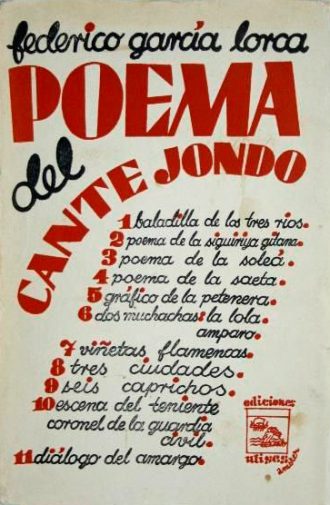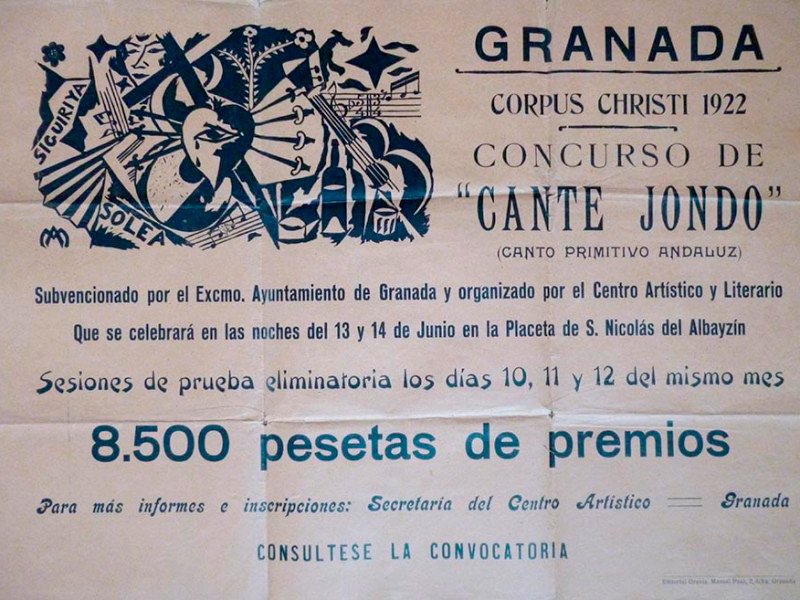
Poem of the Deep Song (Poema del cante jondo) consists of 55 poems, grouped into ten sections plus a prolog poem, Little Ballad of the Three Rivers, which is later than most of the texts in the book and delimits the book geographically and lyrically.
They are poems inspired by Deep Song (flamenco singing), although he did not try to imitate the lyrics of the “cante (singing)”, but to create in the reader the sensation of being in the presence of the primitive sources from which the “cante” springs.
The first sections of the work are dedicated to the siguiriya, the soleá, the saeta and the petenera, each of the modalities of “cante” personified in the form of a woman. The themes of most of the poems are death, frustrated love, despair…
The next four sections are devoted to flamenco, to different characters or to elements of flamenco singing.
Finally, two dialogues were added in 1925 that introduce the dramatic element into the poem.
It was composed at the same time that the Flamenco Song Contest was organized in Granada, during the Corpus Christi festivities, in June 1922, in the Plaza de los Aljibes, in the Alhambra, on the 13th and 14th. The contest was organized by Manuel de Falla, Zuloaga (who designed the set), Miguel Cerón and Federico García Lorca..
Lorca begins to write the poems in 1921. On January 1, 1922 he tells Salazar that he would ensure that the publication of the collection coincided with the aforementioned contest, but it will not be published until May 23, 1931, in the Ulises publishing house, in Madrid. He ended up preparing it with the help of Martínez Nadal. He had been announcing its publication along with Suites and Songs since 1925.
The first edition included a note from the editors warning that it was a book of youth written ten years ago and that it owed much to the poet’s friendship with Falla and to the flamenco singing. He recalls the poet’s versatility and defends the modernity, emotion and universality of his work.
Parallel to the composition of the poems (1921, although there are also poems from 1925) and the preparation of the Flamenco Song Contest, in Granada (the family settled in the Acera del Casino and the poet postponed his return to the Residencia de Estudiantes in Madrid for a few months), he was preparing his speech Historical and artistic importance of the primitive Andalusian chant called “Cante jondo” (Deep Song), given on February 19, 1922 at the Centro Artístico of Granada.
This work demonstrates his debt to Falla, with whom he collaborated closely during these years in Granada, researching popular types of music and literature. He is also indebted to the compilations of couplets by Francisco Rodríguez Marín, Antonio Machado Álvarez and other folklorists, as well as to the Arab, Persian and Turkish poetry of the 19th century compiled by Gaspar María de Nova Álvarez. In addition to this is the “poetic memory” of his childhood in the Vega in Granada. The summer of 1921 in Asquerosa (Disgusting) he learned to play the guitar.
Lorca read several poems from the book at the event held at the theater of the Hotel Alhambra Palace on the occasion of the Cante Jondo (Deep Song) Contest. He also read at a recital he gave at the Ateneo de Valladolid on April 8, 1926, while Jorge Guillén was professor of Spanish Literature at the University of Valladolid. In New York, during the tributes to Antonia Mercé, La Argentina, he gave another recital.

The poems Escena del teniente coronel de la Guardia Civil (Scene of the Lieutenant Colonel of the Civil Guard) and the Canción del gitano apaleado (Song of the Beaten Gypsy) emanae from real situations. In Granada, conflicts between Gypsies and Civil Guard (Spanish Police) were frequent. In November 1919, Lorca, accompanied by Manuel Ángeles Ortiz, witnessed one of these clashes in the center of the city and was very shocked.
These poems starring gypsies and the Civil Guard would later bring him some problems with the Civil Guard, even being denounced years later by a stranger and having to answer and explain his poems before a judge.
He also knew the fear and omniscient power that the guards exercised in the villages when he visited the Alpujarra in 1927 after accompanying his mother to enjoy the curative waters at the Lanjarón spa.
The Diálogo del Amargo (Amargo’s Conversation) which ends with Canción de la madre del Amargo (Song of Amargo’s Mother), is also inspired by a real character, a boy from Fuente Vaqueros who peeked into his dwelling and spat with much contempt inside his house. The poet, still a small child, could not decipher the gesture of that boy called Amargo and, over time, obsessed with this figure, called him “angel of death and despair that guards the gates of Andalusia”.
En la casa blanca, muere
[In the white house,]
la perdición de los hombres.
[mankind’s perdition dies.]
Cien jacas caracolean.
[A hundred ponies prance around.]
Sus jinetes están muertos.
[Their riders are all dead.]
Bajo las estremecidas
[Beneath the trembling]
estrellas de los velones,
[stars of the oil lamps,]
su falda de moaré tiembla
[her skirt of moiré shimmies]
entre sus muslos de cobre.
[between her copper thighs.]
Cien jacas caracolean.
[A hundred ponies prance around.]
Sus jinetes están muertos.
[Their riders are all dead.]
Largas sombras afiladas
[Long, sharpened shadows]
vienen del turbio horizonte,
[advance from the blurred horizon,]
y el bordón de una guitarra
[and the bass string of a guitar]
se rompe.
[breaks.]
Cien jacas caracolean.
[A hundred ponies prance around.]
Sus jinetes están muertos.
[Their riders are all dead.]